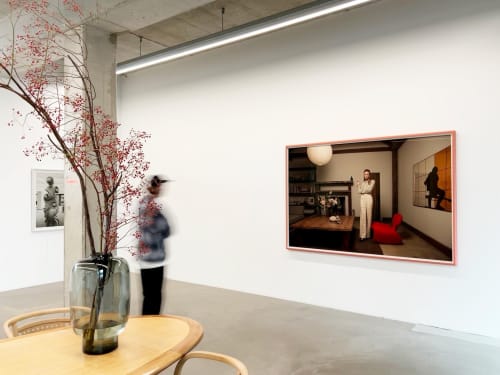Amsterdam's The Ravestijn Gallery has opened I'M SORRY DAVE showcasing director Stanley Kubrick's global impact on the creative industry. The exposition and the works presented on it take the viewer into the atmosphere of retrofuturism, inspired by the iconic film 2001: A Space Odyssey.
About the exhibition
The film 2001: A Space Odyssey, which premiered worldwide in 1968, is still one of the exemplary works in the science fiction genre. Five decades after the movie was released, The Ravestijn Gallery team decided to recall the magnitude of the all-encompassing influence of the world created by Kubrick. Echoes of the aesthetic universe that the director designed can be found today in the design of modern data centers, self-driving cars and other technological advances.
The ironic name of the exhibition project - I'M SORRY DAVE - also became a direct reference to the film. This phrase in the movie is spoken by the robot computer HAL 9000 - the personification of artificial intelligence, which sooner or later can take precedence over the human mind.
Works
All the projects presented at the exhibition, from photographs to sculpture, are somehow integrated into the theme of the film, reflecting the recognizable cinematic universe through aesthetics, images, form, as well as a combination of the supernatural and the everyday.
Space Odyssey Spacesuit, 2019 #1 & Anechoic Chamber, 2018 by Vincent Fournier

Space Odyssey spacesuit #1, Sylmar, USA, 2019 © Vincent Fournier / courtesy The Ravestijn Gallery
The work of the French artist and photographer Vincent Fournier explores the relationship of the past, present and future through the prism of utopian ideas and sci-fi motifs. From the very beginning of his career to the present day, the author's main passion has been space - such a commitment has opened him access to leading space and research centers around the world, from NASA to the European Space Agency. Fournier's photographs are notable for their close attention to architectural form, precise aesthetics, and contrasting scales. His Space Odyssey Spacesuit #1 is inkjet-printed on paper and finished with a hand-painted wooden frame.

Anechoic Chamber, [ISAE], Toulouse, 2018 © Vincent Fournier / courtesy The Ravestijn Gallery
Another work that reflects Fournier's approach and key motives in his practice is the Anechoic Chamber. Created in the same technique, the work was included in the Space Utopia series.
The Dance of Venus, 2019 by koen hauser

The Dance of Venus, 2019 © Koen Hauser / courtesy The Ravestijn Gallery
Dutch artist Koen Hauser works in the photography genre, exploring philosophical and psychological themes in his practice. His photographs are primarily focused not on the aesthetic component, but on the idea underlying the captured moment, whether it be images of mythology, religion, animism and other philosophical currents. The work The Dance of Venus, included in the exposition, was created by Hauser as part of the Skulptura series.
Hands: Corn, 2020 by Martina Souter

Hands: Corn, 2020 © Martina Sauter / courtesy The Ravestijn Gallery
In the work of Martina Souter, one can notice the synthesis of modern photography and film photography: with the help of these two creative tools, she explores the phenomenon of the image. One of the main motives in the artist's creative research is artificial intelligence and its impact on people's daily lives. Some of her works are reminiscent of metaphysical still lifes, while in others traces of human nature are noticeable.
Rianne van Rompaey / H.A.L. 9000, 2019 by Inez & Vinoodh

Rianne van Rompaey / H.A.L. 9000, 2019 © Inez & Vinoodh / courtesy The Ravestijn Gallery
Dutch-New York duo Inez & Vinoodh are known for their extravagant shots that cross the line between art and high fashion. In their practice, the authors explore the boundaries of art and fashion photography, combining innovative digital developments with a bold aesthetic sensibility. The work presented at the exhibition, Rianne van Rompaey / HAL 9000, is made using pigment printing on watercolor paper.
Wikileaks, Pionen Data Centre – Stockholm, Sweden – 04/11/02014, 2014 by Philippe Braquenier

Wikileaks, Pionen Data Centre – Stockholm, Sweden – 04/11/02014, 2014 © Philippe Braquenier / courtesy The Ravestijn Gallery
Images by Belgian photographer Philippe Braquenier take the viewer to modern data centers - the place where all the information of mankind is stored. The author reflects on the obsession of modern man with new information in an era when it is becoming more and more open and invulnerable. Gradually, this idea turns into Braquenier's photographs into more global studies - about evolution, sustainability, as well as the risky and ambiguous nature of the digital revolution.






